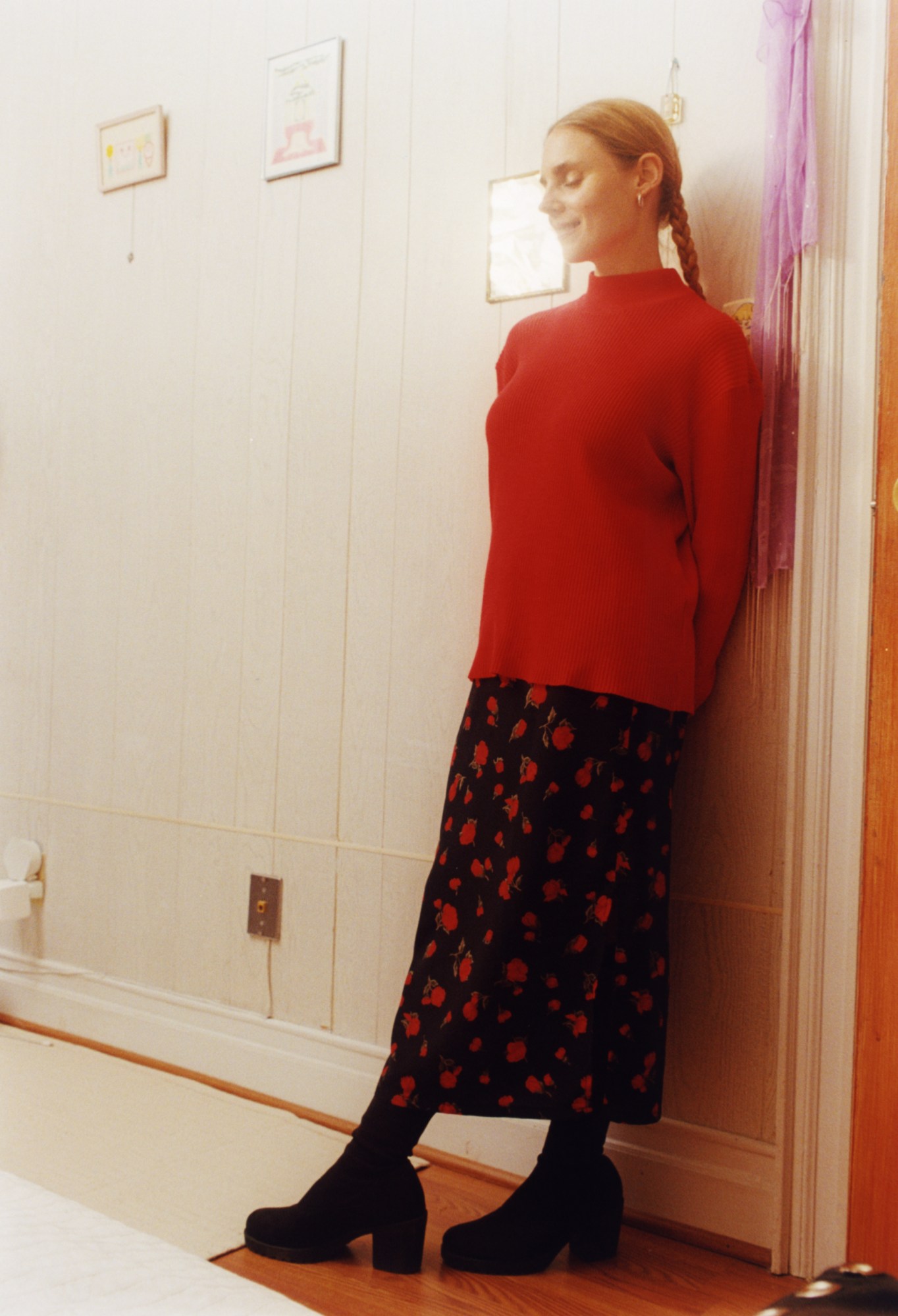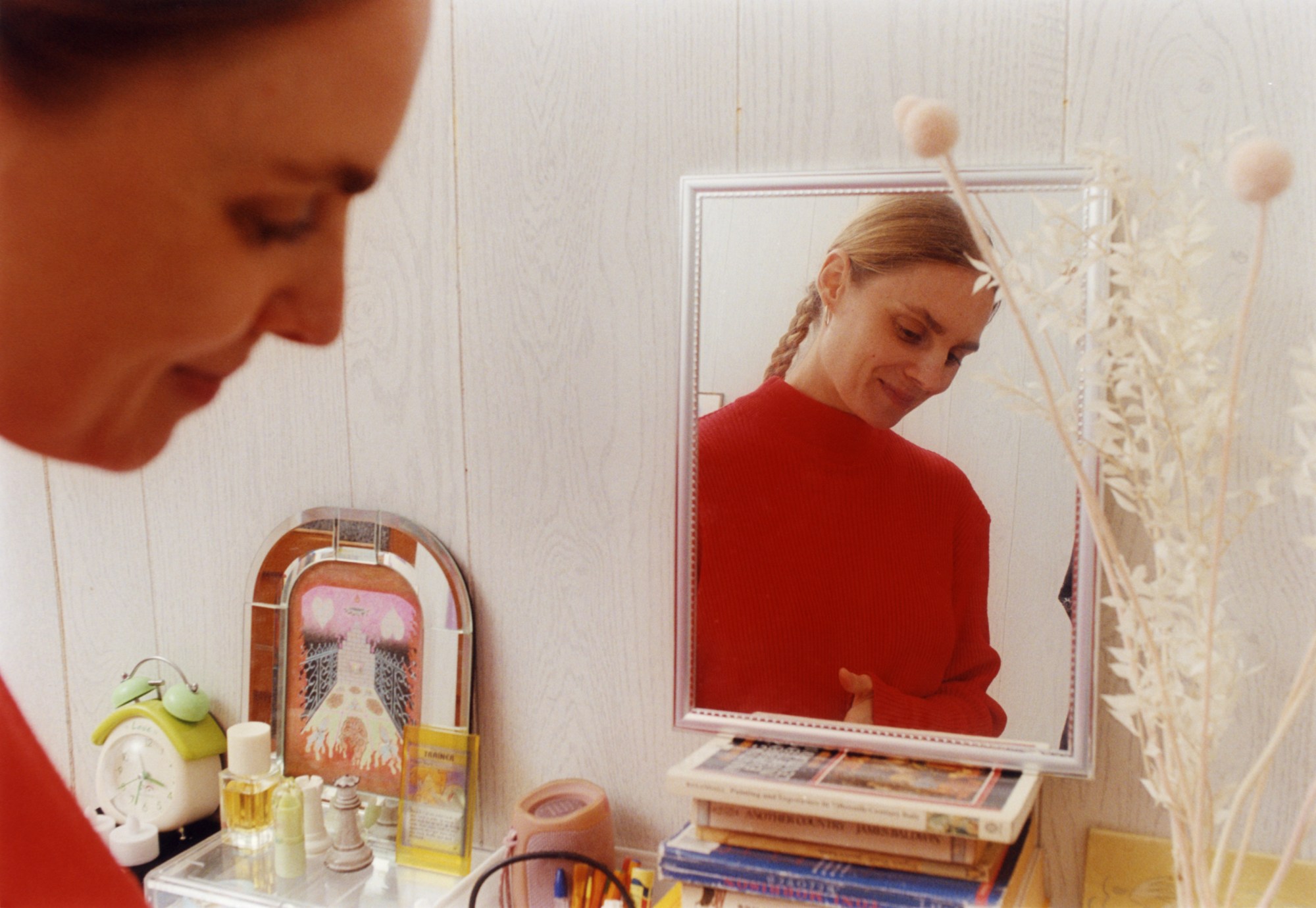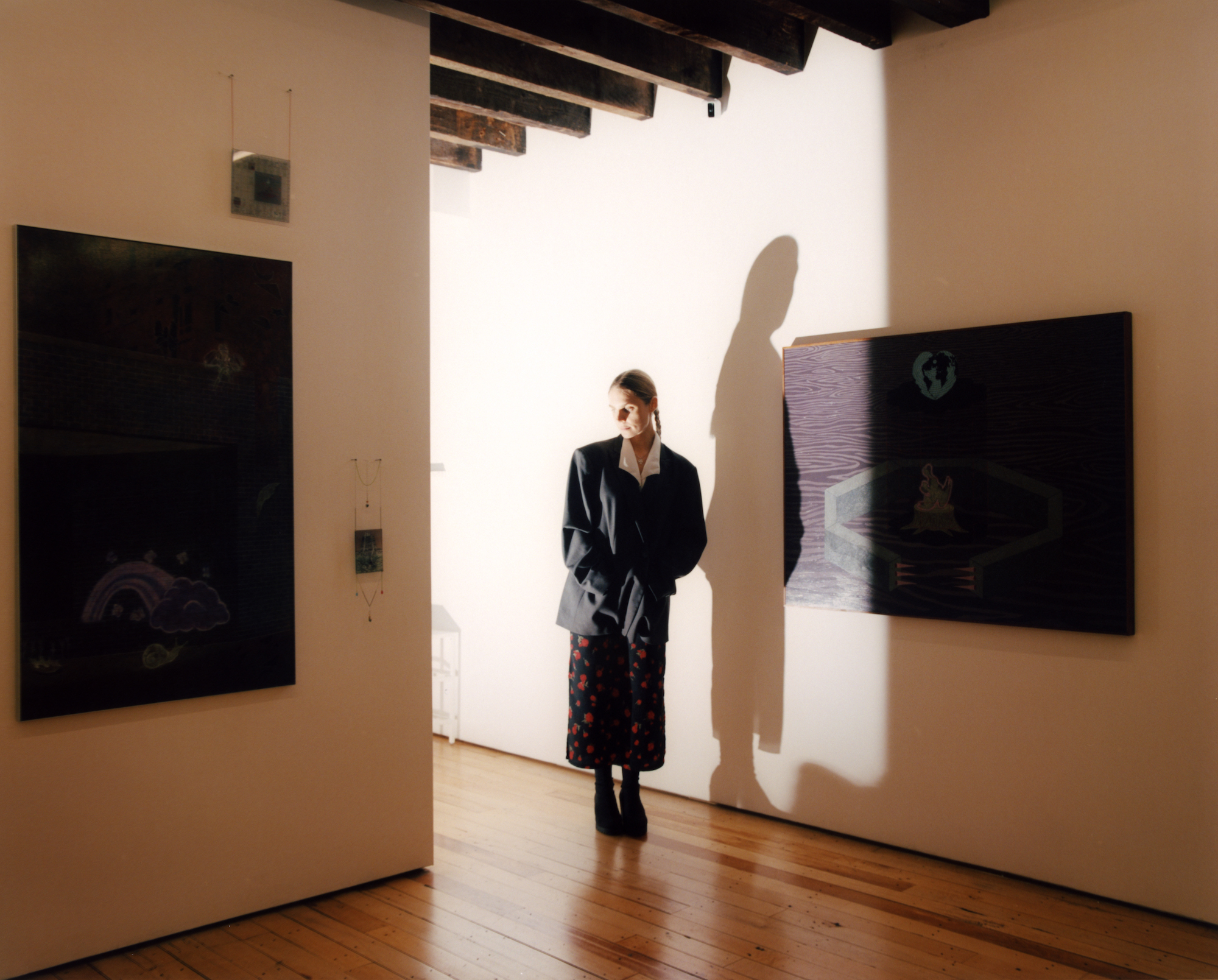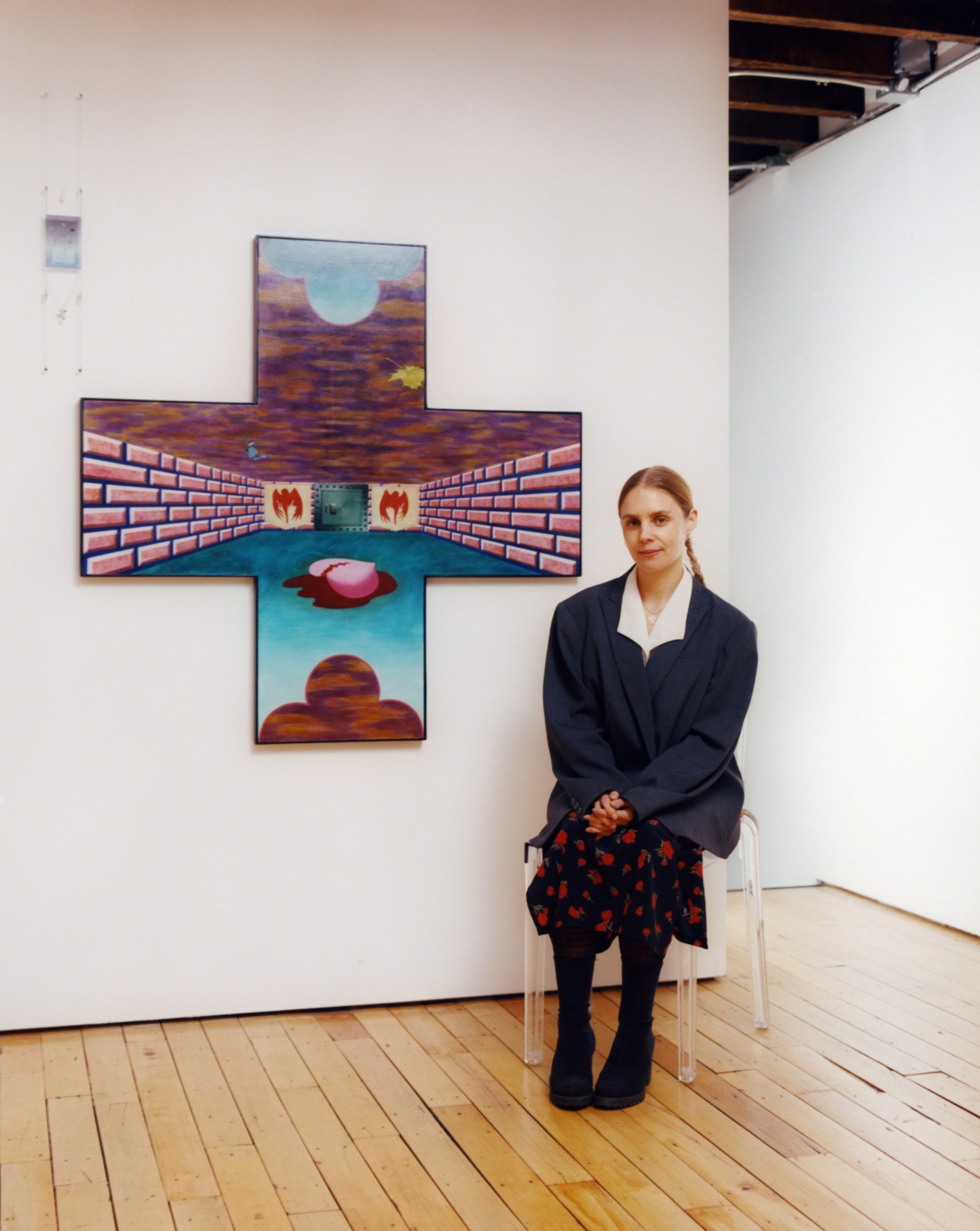“I had a potent religious experience when I was about 10, so that had a big influence on me,” artist Gitte Maria Möller says. “I guess it’s that we are naturally inclined to want to find some form of psychic relief. Your mind and soul want to hold onto something. And at the time, for me, that was the church. While I might not agree with some of the doctrine, this is why a spiritual life is important.”
The South African-born, New York-based artist just opened a new exhibition, A dreaming hand, wounded by thorns, at the Rachel Uffner Gallery on the Lower East Side. On display are a series of large-scale paintings and digitally transferred drawings, framed in handcrafted wiring and adorned with charms, that demonstrate the visual impact of a secluded Protestant upbringing in Cape Town, as well as the growing sway of popular culture on Gitte; the work features fantastical scenes with an array of references, from My Little Pony characters to early computer game aesthetics.

“I think a lot about the magic of childhood and how we imbue toys, objects or literally anything with magical status, and I like to bring those ideas into my work,” she explains. Panel paintings feature whimsical details like butterflies and bunny rabbits, sci-fi fairies or those inspired by witchy characters on the Afrikaans TV show Liewe Heksie. The work is reflective of a 90s/00s upbringing, an aesthetic that’s endlessly referenced today, yet through it Gitte methodically processes feelings, trauma and tries to make sense of our modern world.
To coincide with the exhibition and an upcoming group show called Small Hours at Alice Black Gallery in London, we spoke to the artist about growing up in an isolated South African church community and the transition from teenage angst to self-empathy.
Give us some background on your New York exhibition. How did it all come about?
The show spans five years worth of work and it’s rewarding to see the stylistic change in painted surface over that time. My paintings are kind of neurotic in the sense that they’re extremely structured and there’s very little “spillage”, but I also think that over time I’ve become more gentle as a painter, as I have hopefully become more gentle in my everyday life towards myself and others.

What was your childhood like, growing up in 90s Cape Town suburbia?
It was very idyllic. I played outside a lot, and could roam the neighbourhood alone. I built forts in the garden, did arts and crafts with my mom. I played with my brothers. I went to Sunday school — not to church since my parents weren’t religious, but it was expected by the community, which was Protestant, that young people attend Sunday school. I had a potent religious experience when I was about 10, so that had a big influence on me.
I was also a bit of an awkward kid and developed early. I was bullied at different points, which made me mistrust people. So I left the church when I was 11 and started reading a lot of fantasy novels and became obsessed with CG Jung. My dad took us camping and hiking a lot, which instilled a love of nature. I also loved computer games — Age of Empires 2, Tomb Raider 2 and Diablo 2. One of my favourite characters growing up was from an Afrikaans TV show called Liewe Heksie (or ‘dear little witch’) and I liked to style myself after her.
I grew up speaking Afrikaans with my family and in school. It’s a kind of Creole, West Germanic language, which developed during the Dutch Cape Colony. Everything kind of changed when we moved to the inner city when I was 12; I started fighting with my dad a lot. This was also an important time, moving to the city and experiencing extreme teenage angst… I now spend a lot of time thinking about empathy and forgiveness.

Wait, can you expand on the religious experience?
I was at church and felt the Holy Spirit enter my body. I can’t remember the time of year, but for some reason I was at church in the evening with my friends. It was only young people and we were singing songs. And I guess I must have felt very moved, or a part of something. I remember that I wanted to tell someone that this had happened to me for weeks after, but I was very shy and kept it to myself.
Now, I don’t feel like it’s something that’s left me, which is really special I think. I only told people very recently, and then realised it’s not that common. I thought it happened to most religious people. I guess it’s that we’re naturally inclined to want to find some form of psychic relief. Your mind and soul want to hold onto something. And at the time, for me, that was the church. While I might not agree with some of the church doctrine, this is why a spiritual life is important.
Let’s talk about your previous show at Cape Town Unitarian Church, Misty’s Tears. How’d you go about securing a church?
I’m really interested in showing in off-site spaces, since my work is already very influenced by architecture and other finer details in the urban landscape. At first I wanted to use a crypt in a Catholic church, but there was too much red tape involved.
The Unitarian Church was suggested by a friend. They used to host First Thursdays events before the pandemic, and they also function as a kind of community centre hosting AA/NA meetings and the like, so they were happy to lease the space to me. They already had several interesting shrines around the room when I came to look at the church. Hans, the groundskeeper and Nima, the resident pastor, were really accommodating and let me move all the furniture around; they were also very excited about showing the work. Unitarianism is a non-denominational practice, so it made sense in the space as my practice has a devotional or ecclesiastical quality to it which is, in my mind, not doctrinal.
Physically, the building itself is extremely small for a church, very cozy and only has windows on one side facing an alleyway. The building was completed in 1850 by English settlers, and has the original wooden ceiling and floors, a carved balustrade and corbels, all in the Gothic revival style.

What are your thoughts on the afterlife?
My dad passed away suddenly from a rare, very aggressive strain of cancer in 2019, and that has made my relationship to death — but also to life — much more acute. I’m not sure how to say it, but I think about death a lot, and the fragility of the body. Maybe because I’m more in love with life than I was before, or I appreciate life more. I spend a lot of time going to cemeteries; I find it very calming and it’s also where I feel the least alone.
My relationship to Christianity is helpful here in that I believe in Heaven, or have this feeling that all beings, no matter if they were good or bad, somehow live on in a parallel, but much safer, more peaceful realm. I think my dad is at peace. Almost especially because he wasn’t peaceful in life. I don’t believe in reincarnation or karma or hell. I guess it just seems like hell already exists on earth.

Tell me about the more sculptural work you make, the wireframe pieces and the charms.
I started making the wireframe work after I came back from visiting NYC in 2020, and saw that the wrought-iron fences in my drawings — from fences I had photographed in the city — had strong visual resonance with a picture frame my parents had bought at a craft market in Cape Town in the early 90s. I’d moved back in with my mom at the end of 2020, and it was lying around in a box with other discarded pictures. So, I started working with a Zimbabwean wire artist, Farai Kanyemba, to make my own designs as frames/extensions of the drawings, and now more recently, my perspex work. I like that the frame isn’t solid, but rather like a mesh, and the picture itself is transparent too… a kind of portable stained glass window.
I think this work is a good counterpoint to creating big heavy objects like panel paintings, which take up a lot of space and are heavy. I also like that it engages with the craft of wire art, which is a popular Southern African craft for selling street art or curios. This work naturally led into making the charms, as I thought about attaching other kinds of objects to the plexiglass. They remind me of the suncatchers I made with my mom when I was a little girl.

In terms of your process, why do you think you’re drawn to certain recurring symbols, characters and archetypes?
My compositions for my digital collages — or my paintings and drawings, which are based on those collages — usually start with a single character or structure like a fence, wall or frame. I then start populating the picture plane depending on what characters and symbols I envision in the space. I have a lot of reference images I work with, so it can be trial and error and feeling out what is right, but often something will stick with me and I’ll keep using it until its magic wanes or my obsession decreases and I have to move onto something else.
My work is a collage of high/low, ranging from pop culture icons and images from my childhood and teens, to things I see around the city on walks or through searching online, but then I also reference images and themes from art history. In an abstract but methodical way I use my work as a way to think through feelings and relationships — in relation to myself and the world around me — so the symbols and characters in the work are really stand-ins for these dynamics.
A dreaming hand, wounded by thorns is on view at Rachel Uffner Gallery in New York through January 6, 2024. Small Hours is on view at Alice Black Gallery in London from 1 December 2023 to 13 January 2024.
Credits
Photography Ashley Markle

